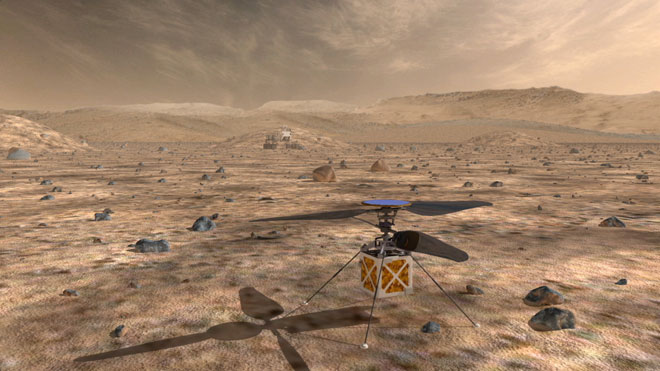
A proposed helicopter could triple the distances that Mars rovers can drive in a Martian day and help pinpoint interesting targets for study. Photo: JPL/NASA.
WASHINGTON (PTI): NASA is working on a small helicopter that could fly ahead of future Mars rovers, checking out various possible points of interest and helping engineers back on Earth plan the best driving route.
Each NASA rover has delivered a wealth of information about the history and composition of the Red Planet, but a rover's vision is limited by the view of onboard cameras.
The images from spacecraft orbiting Mars are the only other clues to where to drive it.
To have a better sense of where to go and what is worth studying on Mars, it could be useful to have a low-flying scout, NASA said.
The Mars Helicopter is a proposed add-on to Mars rovers of the future that could potentially triple the distance these vehicles currently drive in a Martian day, and deliver a new level of visual information for choosing which sites to explore.
"The helicopter would fly ahead of the rover almost every day, checking out various possible points of interest and helping engineers back on Earth plan the best driving route," NASA said in a statement.
Scientists could also use the helicopter images to look for features for the rover to study in further detail.
Another part of the helicopter's job would be to check out the best places for the rover to collect key samples and rocks for a cache, which a next-generation rover could pick up later.
The vehicle is envisioned to weigh 1 kilogramme and measure 3.6 feet across from the tip of one blade to the other. The prototype body looks like a medium-size cubic tissue box.
The current design is a proof-of-concept technology demonstration that has been tested at NASA's Jet Propulsion Laboratory, Pasadena, California.
 Previous Article
Previous Article Next Article
Next Article













The Indian Air Force, in its flight trials evaluation report submitted before the Defence Ministry l..
view articleAn insight into the Medium Multi-Role Combat Aircraft competition...
view articleSky enthusiasts can now spot the International Space Station (ISS) commanded by Indian-American astr..
view article